The purpose of this study is to answer some questions related to internet and social media usage in the GCC. We will examine the number of internet users, broadband subscriptions, social media usage by age group, gender distribution, and the number of daily hours spent online. In this analysis, we will be using Microsoft PowerBI to analyze data from https://ourworldindata.org/internet.
The Gulf Cooperation Council (GCC) consists of six countries in Western Asia. These countries are: Bahrain (BHR), Kuwait (KWT), Oman (OMN), Qatar (QAT), Saudi Arabia (SA), and United Arab Emirates (UAE).
The population of these countries in 2022:
| Country | Population |
| Bahrain | 1,501,635 |
| Qatar | 2,799,202 |
| Oman | 4,527,446 |
| Kuwait | 4,670,713 |
| UAE | 9,282,410 |
| Saudi Arabia | 35,013,414 |
You can see the interactive graph here
The Internet, sometimes called simply « the Net, » is a worldwide system of computer networks in which users at any one computer can, if they have permission, get information from any other computer (and sometimes talk directly to users at other computers).
January 1, 1983, is considered the official birthday of the Internet. Before this, the various computer networks did not have a standard way to communicate with each other.
The inventor of the World Wide Web (WWW) was the British scientist Tim Berners-Lee who created a system to share information through a network of computers.
A new communications protocol was established called Transfer Control Protocol/Internetwork Protocol (TCP/IP).
This started to change in the 1990s, at least in some parts of the world. By the year 2000, almost half of the population in the US was accessing information through the internet. But across most of the world, the internet had not yet had much influence – 93% in the East Asia and Pacific region and 99% of South Asia and Sub-Saharan Africa were still offline in 2000. At the time of the .com-crash, less than 7% of the world was online.
Fifteen years later, in 2016, three-quarters (76%) of people in the US were online and during these years countries from many parts of the world caught up: in Malaysia, 79% used the internet; in Spain and Singapore 81%; in France 86%; in South Korea and Japan 93%; in Denmark and Norway 97%; Iceland tops the ranking with 98% of the population online.
Nowadays, 99.2% of people in the GCC use the Internet.
How many internet users do the GCC countries have?
Internet users are individuals who have used the Internet (from any location) in the last 3 months. The Internet can be used via a computer, mobile phone, personal digital assistant, games machine, digital TV etc.
The Internet has been one of the most transformative and fast-growing technologies.
We can see that clearly by the following Area chart.
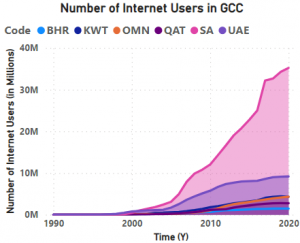
You can see the interactive graph here
In this graph, we used multiple colors to distinguish countries, and it shows the number of people who used the Internet from 1990 to 2020.
In the GCC countries, the Internet did not exist until the end of 1992.
Kuwait became the first country to recognize the internet in 1993, and 1506 of its residents began using it. All GCC countries except Oman had access to the Internet until 1997, when it became available to 9876 residents.
With the development of the Internet in GCC countries, the number of users grew more and more with the increase in the population.
It’s clear that Saudi Arabia’s Internet usage increases more than other countries every 10 years due to its population (35,013,414).
GCC Broadband Subscription: how did it evolve over time?
Broadband is the transmission of wide bandwidth data over a high-speed internet connection.
Bandwidth, measured in bits or Mbps (Megabits per second), is the volume of data that can be carried via a broadband connection per second, and is a key indicator of “internet speed”.
So, what is broadband? According to the Federal Communications Commission (FCC), the definition of broadband internet is a minimum of 25 Mbps download and 3 Mbps upload speeds.
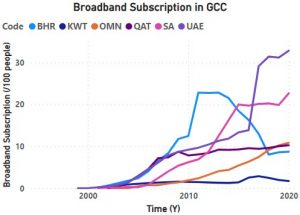
You can see the interactive graph here
Broadband subscriptions began in UAE in 1999 and 2000, at 0.01 then 0.06 Mbps per 100 people.
Initially, it appeared in Bahrain, Kuwait, and Saudi Arabia, and UAE had a higher broadband subscription rate.
In 2002, all GCC countries adopted broadband subscriptions.
Additionally, Bahrain (0.68 Mbps per 100 people) and Kuwait (0.49 Mbps per 100 people) experienced an increase in Internet speed, knowing that the UAE had faster speeds previously. It has been Bahrain, Qatar, Saudi Arabia, and the UAE that have improved their internet access the most since 2003.
Comparing Kuwait with other GCC countries since 2010, Kuwait has always had the slowest internet.
The highest internet speed was observed in Bahrain (22.82 Mbps per 100 people) in 2013.
In the following years, Bahrain’s Internet speed declined and reached 8.05 Mbps per 100 people in 2018.
The UAE improved its internet speed by 210 percent between 2016 and 2017 (it was 13.86 and became 29.11 Mbps per 100 people).
In the end, in 2020, the UAE was the country with the fastest internet speed with 32.81 Mbps per 100 people, followed by Saudi Arabia with 22.66 Mbps per 100 people, then Oman with 10.85 Mbps per 100 people, and so Qatar has 10.28 Mbps per 100 people. Then is Bahrain, which has 8.75 Mbps per 100 people, followed by Kuwait, which has 1.73 Mbps per 100 people.
This year, how are social media platforms used by different age groups in GCC?
The purpose of this study is to examine how social media platforms are used by age groups ranging from 18 years and older in GCC.
There was a clear division between ages based on color.
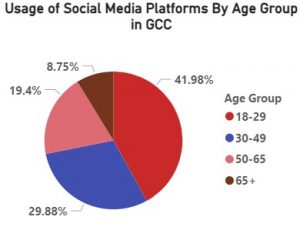
You can see the interactive graph here
As you can see from the pie chart, red is the dominant color with 41,98%, indicating the 18-29 age group.
GCC social media platforms are used most by people between the ages of 18 and 29.
These are the members of the new generation, or the rising generation. This generation was raised in an environment of openness and development, and the dominant technology is the Internet. As we do not forget the situation that the world went through some time ago, this group interprets the use of the Internet as development, acquaintance and learning. Covid forces us to sit at home and use the Internet, either to learn, to communicate, to work, or even to shop.
As for the blue color, which comes in second place with 29,88%, it represents the age group between 30 and 49 years, which indicates that this group is the one who uses the Internet, and their ages indicate that they have experience and workers, which indicates that they use it for the purpose of work, for example.
Third place goes to the pink color, which indicates the age group between 50 and 65 years, and 19.4 percent of this group is still working and capable of understanding development issues and using the Internet.
Finally, it is brown with 8,75%, which is the group of people over 65 years old, and they have the most difficult time absorbing information, which makes it difficult for them to learn and grow. These groups are prone to linguistic, intellectual, assimilation, and other diseases. Their primary use of the Internet is to communicate.
What is the usage of social media platforms by men and women in GCC, and which apps are most commonly used?
In response to the question, we will investigate which applications/platforms are most commonly used by women and men in the GCC.
Pink symbolizes women and blue symbolizes men in this design.
The study was treated in percentage.
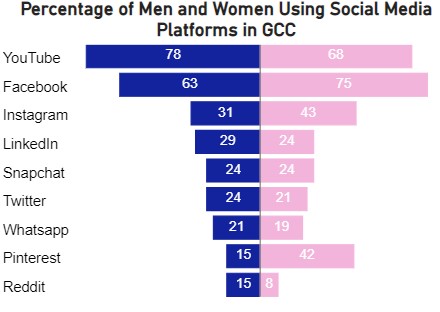
You can see the interactive graph here
Women and men both use YouTube the most, 78% for men and 68% for women according to this tornado chart. Compared to reddit, which was considered the least used, it was used by 15% of men and 6% of women.
In looking at this graph, it can be noted that the interest in these applications can be the same for men and women.
Which device do people in the GCC use most often to access the Internet?
Who doesn’t spend time on the Internet?
It is almost a daily occurrence for most of us to use the Internet in our time.
It is not unusual for us to use the Internet through a variety of different devices, including cell phones, desktop computers, video games, smart watches, headphones, TV, and many more…
Throughout history, internet usage hours have differed based on its development. The first issue with it was that it was limited and not everyone knew how to use it. Additionally, the limited hours of internet use in the past were exacerbated by the lack of devices with internet access. However, with the development of the Internet and the presence of many devices that interfered with the Internet, our use of the Internet has increased during the day.
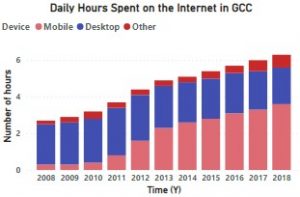
You can see the interactive graph here
In 2008, people used the Internet on their mobile phones 0.3 hours per day, and it kept increasing until 2018, to became 3.60 hours per day.
As a result of the development of smartphones, since in 2008, phones did not have smart features.
Desktops were used the most in 2008, with 2.2 hours per day, and their use changed in 2011, when they reached their highest point (2.6 hours per day) and then began to decline until they reached 2 hours per day in 2018.
As for the other, it began with 0.2 hours of usage per day in 2008 and went up to 0.4 hours per day in 2010, and then remained stable until 2014 with 0.3 hours per day. After that, it increased until it reached 0.7 hours per day in 2018.
Conclusion
As a result, the number of internet users, broadband subscribers, and users of social media platforms is expected to continue to grow for every age group and gender distribution in the GCC as a result of the upcoming generations who will spend more time on digital devices with access to the internet.
The internet has already changed the world, but the big changes that the internet will bring still lie ahead. Its history has just begun.
